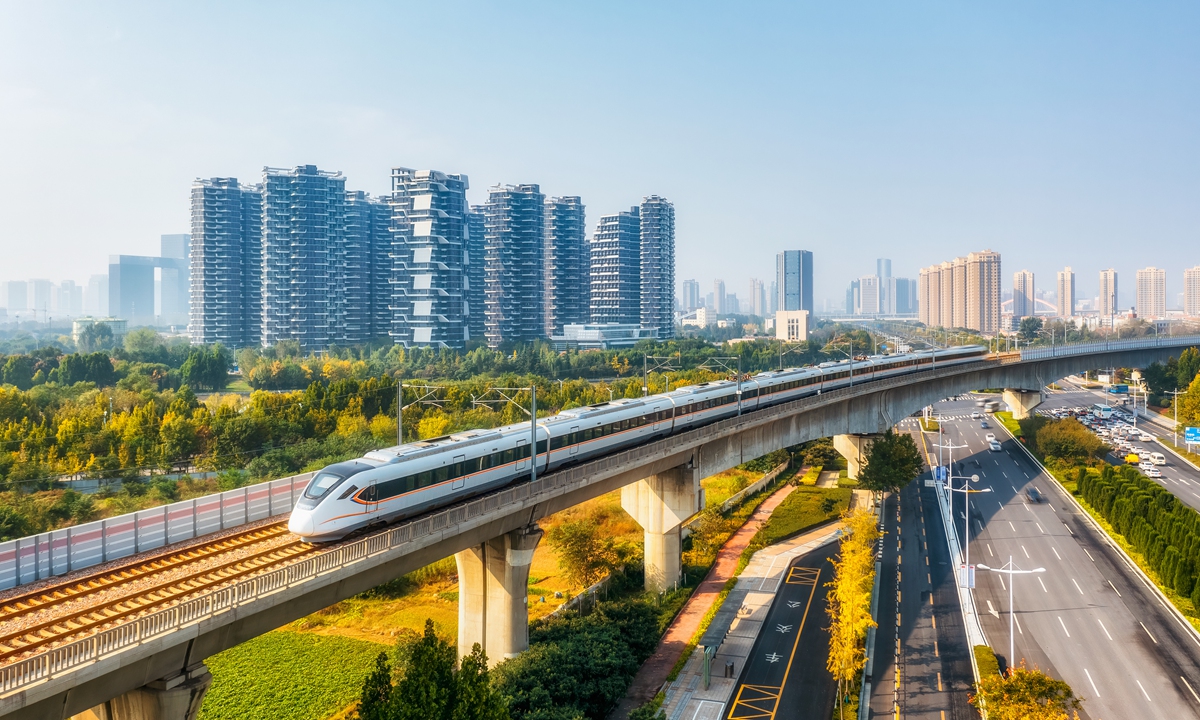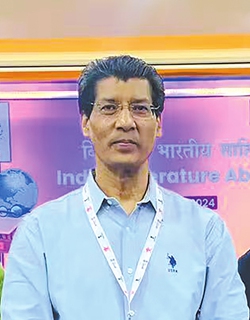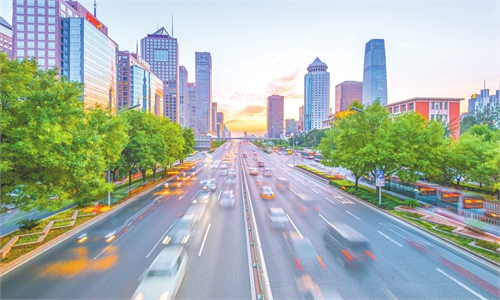
A high-speed train travels along the intercity railway between Zhengzhou and Kaifeng, cities in Central China's Henan Province. Photo: VCG
Editor's Note:For many foreigners, China may remain a mysterious land. However, for some China hands, the real China is credible, appealing and respectable. Their research and observations provide authentic reflections of China's transformation, mirroring the country's achievements and attractiveness. On October 1 of this year, the People's Republic of China (PRC) will celebrate the 75th anniversary of its founding. The Global Times launches a series titled "China Hands: My China Voyages" to share the connections, stories and insights of influential scholars and analysts who study China, narrating the changes and accomplishments they witness in China, and presenting a multifaceted view of the country.
In the second article of the series, B. R. Deepak (Deepak), professor of Chinese and China studies at the Center of Chinese and Southeast Asian Studies, Jawaharlal Nehru University, shared his stories with Global Times (GT) reporter Qian Jiayin.
GT: As a famous Sinologist and translator in India, you have written and translated many books about China. How did you establish a connection with China? Why are you interested in studying China?
Deepak: My first conscious connection with China came through a book on East Asian history that I borrowed from the college library during my senior year of high school. For the first time, I was not only exposed to Chinese civilization, but also to its influence on countries like Japan.
As for why I am interested in studying China, I believe that both India and China are the only continuing ancient civilizations that have witnessed rises, influenced each other spiritually and materially, and contributed significantly to global development. Even today, it seems history is repeating itself - we are witnessing the rise of both India and China. Therefore, given the complementarities and potential of these two vast markets, there is a pressing need to improve our security environment so that people in the region can enjoy peace and prosperity.
GT: You mentioned in an interview that you studied at the Department of History at Peking University in 1991. Over the years, what changes in China have impressed you most?
Deepak: To be frank, in 1991, I didn't find much difference between Indian metropolitan cities and Chinese cities, except for the fact that Chinese cities were less chaotic. There were very few skyscrapers in Beijing, and the roads were not very wide. Foreign goods were scarce and available only in a few designated places, like the Friendship Store.
It was during my second visit in 1996 and again in 2001 that I witnessed earth-shaking changes. Public amenities such as roads, the subway system, railways, housing and sewage systems were expanded unprecedentedly; university campuses were flooded with foreigners from across the globe; skyscrapers were rising all over the place; and foreign goods were now being made in China, with mega shopping complexes mushrooming all around. The cities were bustling with migrant laborers, and massive capacities were being built for the future.
After China's entry into the WTO, industrialization and modernization accelerated further. Economic growth in the last two decades has been phenomenal. In the second decade, China emerged as the leading trade partner both regionally and globally, bridging the technological and military gap with the US.

B. R. Deepak. Photo: Deepak's X account
GT: How do you view the 75th anniversary of the founding of the People's Republic of China as a historical milestone?Deepak: It is a remarkable journey from being "poor and blank" to becoming a rich and powerful China. In 1949, China was primarily an agrarian economy, with a per capita disposable income of only 49.7 yuan (about $7) and a life expectancy of just 35 years. Today, more than 66 percent of the Chinese population lives in cities. GDP per capita in China is expected to reach $12,758 by the end of 2024 and China's average life expectancy has reached a record high of 78.6 years. Today, China boasts the largest network of high-speed railways in the world, estimated to be around 45,000 kilometers long. Since the founding of the PRC, nearly 800 million people have been lifted out of poverty.
The Belt and Road Initiative (BRI) proposed by China now focuses on "small and beautiful" projects, centered around information technology, high-tech and green industries aimed at resource optimization. In simple terms, the emphasis is on innovation and quality over quantity. This also means that China's economy will be transitioning from relatively high growth to moderate and sustainable growth.
GT: How do you view China's contributions to the international community over the past 75 years?
Deepak: I believe the initiatives proposed by China - Global Development Initiative, Global Security Initiative and Global Civilization Initiative - have evolved into the new pillars of China's diplomacy in the new era. The mainstay of China's foreign policy is the "community of shared future for mankind," which I think has two major components: the major power relationship and the BRI. The former involves building China's relations with the US and other major countries based on mutual respect, equality and mutual benefits. The BRI is primarily geared toward China's engagement with developing countries to build capacities in various areas.
Additional components, such as the three initiatives, have been added to the larger framework of the "community of shared future for mankind" paradigm. Some of the stated objectives of these initiatives include poverty alleviation, food security, financing for development, climate change and green development, industrialization, the digital economy, common security, and learning from civilizations. People are at the center of all these initiatives.
GT: You have been committed to promoting exchanges and mutual learning between Chinese and Indian students for a long time. How do you evaluate the importance of these exchanges and mutual learning between China and India?
Deepak: I believe that the more people understand the Chinese language, the better approaches they will formulate for understanding China. This will also enable Indian scholars to develop their own perspectives on China rather than relying on external sources and viewpoints, which may not necessarily align with the development of India-China relations. Mutual exchange, especially people-to-people exchange, is the foundation of good neighborly relations. Both sides must improve the overall environment and normalize the relationship in all areas.
GT: You mentioned in a comment that "the 'trade only and nothing else' paradigm of Indian diplomacy with China does not augur well for India's rise and its cultural confidence." How should India break this paradigm?
Deepak: The paradigm reflects the current state of India-China relations. Willingly or unwillingly, India appears to be committed to trading with China, with trade exceeding $136 billion, despite facing a deficit of over $100 billion. However, the rest of the relationship is in jeopardy. I believe that, as a rising power, India must take advantage of China's capital and technology to strengthen its own capacities. If India sees this as a strategic opportunity, it must engage with China while also engaging with other major powers.
Moreover, both countries still share many commonalities and significant potential. Sectors that could benefit include building capacities in agriculture, labor-intensive industrial supply chains (where "Make in India" could serve as a platform), urbanization and green development, in addition to existing sectors such as electronics, mobile telephony and green energy.

